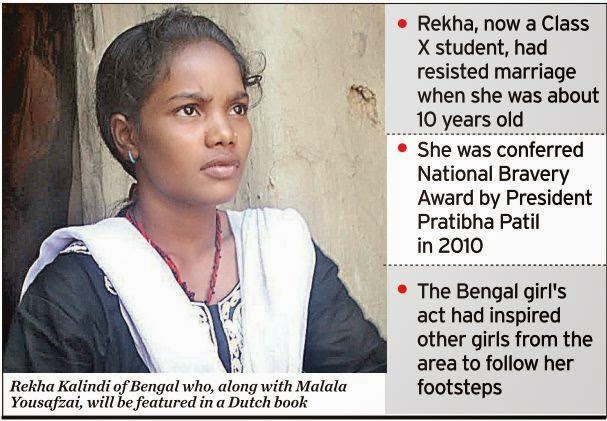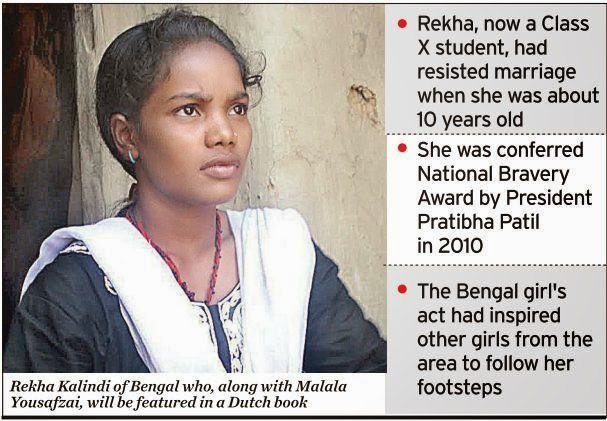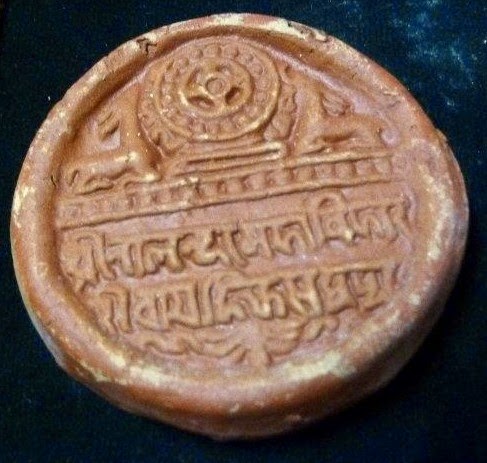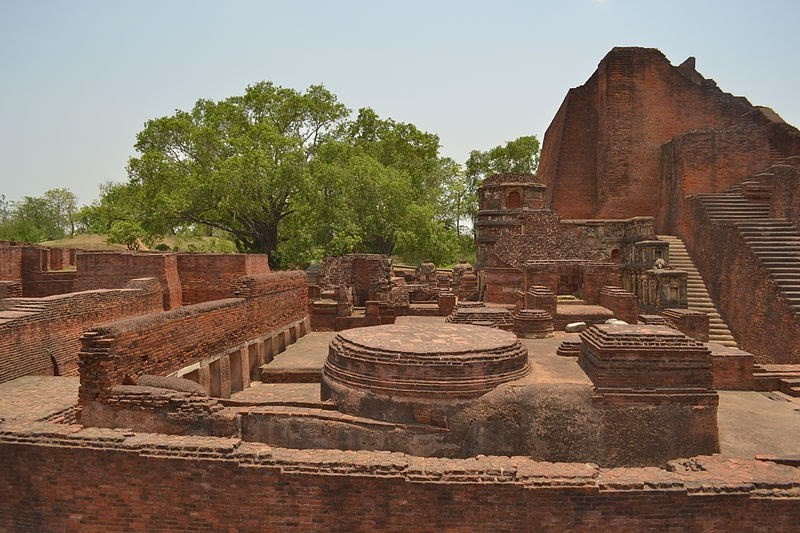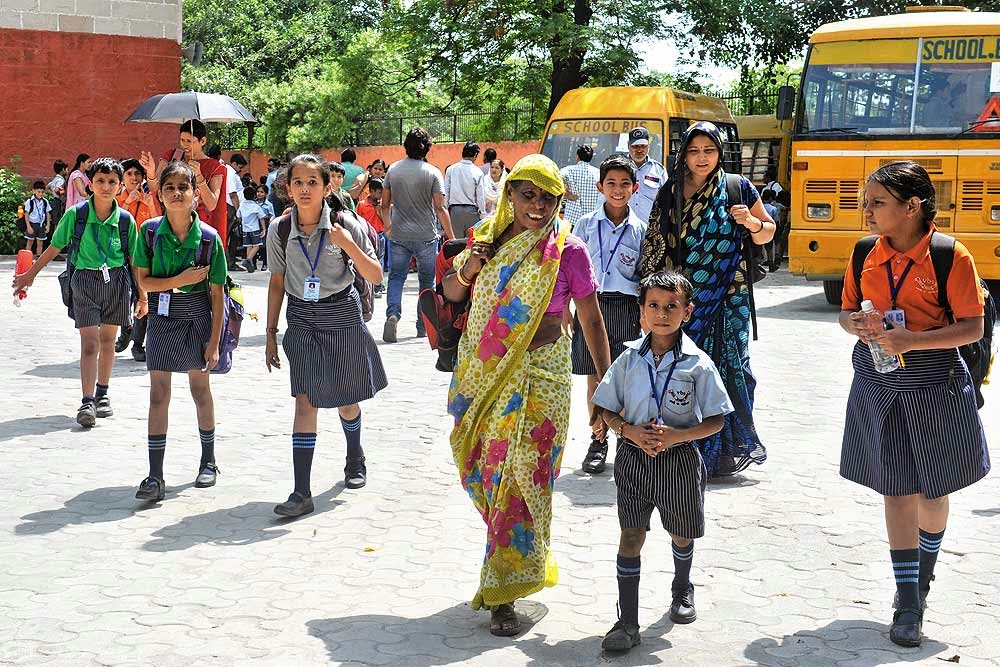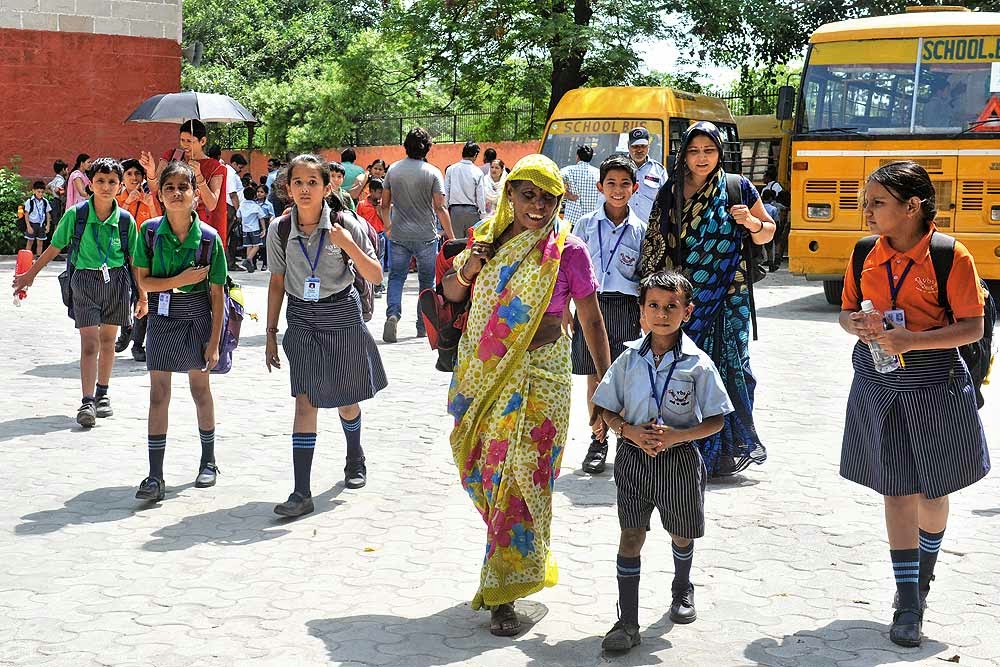……Shiva, dressed in a burgundy
sari and a shawl the color of rust….“We would
have no hunger in the world if the seed was in the hands of the farmers….They want to take that away”…..Shiva argues that the prevailing model of industrial
agriculture….places an
unacceptable burden on the Earth’s resources….Shiva has contempt for farmers who plant monocultures….“They are ruining the planet…..They are
destroying this beautiful world”….
….
The list of power ladies from India who carry high name recognition in the West (and the rest) reads as follows: (1) Arundhati Roy, (2) Vandana Shiva, (3) Sonia Gandhi, and (4) Mother Teresa. For people keeping score we have (3) christians and (1) brahmin, also (2) are naturalized citizens.
How about the others? Indira Gandhi is probably fading from memory, even as Mayawati rises as a Dalit icon (she will need to capture the Red Fort for true greatness). We are guessing that not too many westerners know about Indra Nooyi and other corporate bosses.
Indian music and dance do not have (yet) a female Ravi Shankar, even though his first wife Annapurna Devi (born Roshanara Khan, daughter of Alauddin Khan) was more talented and stopped performing because of the unhappiness expressed by her husband. The Shankar progeny Geetali Norah Jones Shankar and Anoushka Shankar would (at most) be recognized as Americans with Indian influences.
Bollywood is a non-starter as well, westerners would barely know a Freida Pinto from a Priyanka Chopra. There was a time when we thought that Kareena Kapoor and/or Aishwariya Rai will break through into Hollywood but what is really needed is a James Bond lady, and there are none that fit the bill right now.
In sports there is (sad to say) no female Sachin Tendulkar (not even a PT Usha) equivalent. Indians barely rate on the sports scene anyway so this is not much of a surprise.
So….what then about Vandana Shiva? VS is a Gandhian (self-declared) in her relentless
opposition to modernity. She is a nuclear physicist (self-declared) who
hates fertilizers (and Monsanto). Gandhi Mark-I was nominated multiple times
for Nobel Peace prize, we hope that Gandhi Mark-II will get her reward at an early date (she is certainly as deserving, if no more, than Obama and the European Union).
Why do people, especially left-liberals in the West (who have benefited the most from the bounties of modernity) love her so much for her love of traditional ways?
…..
Like Gandhi, whom she reveres, Shiva questions
many of the goals of contemporary civilization. Last year, Prince
Charles, who keeps a bust of Shiva on display at Highgrove, his family
house, visited her at the Navdanya farm, in Dehradun, about a hundred
and fifty miles north of New Delhi.
Charles, perhaps the world’s
best-known critic of modern life, has for years denounced transgenic
crops. “This kind of genetic modification takes mankind into realms that
belong to God and God alone,” he wrote in the nineteen-nineties, when
Monsanto tried to sell its genetically engineered seeds in Europe……..Shiva, too, invokes religion in her assault on agricultural
biotechnology. “G.M.O. stands for ‘God, Move Over,’ we are the creators
now,” she said in a speech earlier this year.
…
As we see it, Westerners are genuinely alarmed about the degradation of the environment (and inflation of food prices) if/when billions of third world peasants demand a “western” lifestyle (quadruple delight of chicken, beef, pork, and fish). They would not mind if a few Indian agents can persuade Indians that blind following of the West is immoral. If you are a super-caste woman preaching the virtues of Indian (vegetarian, organic) civilization then more power to you.
…..
PRESIDENT George W Bush angered Indians in May 2008 when he said that
India, where the “middle class is larger than our entire population”
the demand for better food had caused “[world] price to go up.”
…
Almost the same day in May, EU Commissioner for agriculture
Mariann Fischer Boel told the European Policy Centre: “Those who see
biofuels as the driving force behind recent food price increases have
overlooked not just one elephant standing right in front of them, but
two. The first elephant is the huge increase in demand from emerging
countries like China and India. These countries are eating more meat…
So a dietary shift towards meat in countries with populations of over 1
billion people each has an enormous impact on commodity markets,” noted
the Danish commissioner.
…….
Under any other circumstance a person like Vandana Shiva would be denounced as Hindu supremacist and a Luddite (the original Gandhi
was very much denounced as such). But these are tough times and the rule-book has changed. Today if you preach against
consumerism by lesser, third-world, people, you are sure to be loved as a
rockstar…a beautiful moon without a single blemish.
……………….
Early this spring, the Indian environmentalist
Vandana Shiva led an unusual pilgrimage across southern Europe.
Beginning in Greece, with the international Pan-Hellenic Exchange of
Local Seed Varieties Festival, which celebrated the virtues of
traditional agriculture, Shiva and an entourage of followers crossed the
Adriatic and travelled by bus up the boot of Italy, to Florence, where
she spoke at the Seed, Food and Earth Democracy Festival.
At each stop, Shiva delivered a message that she has honed for nearly
three decades: by engineering, patenting, and transforming seeds into
costly packets of intellectual property, multinational corporations such
as Monsanto, with considerable assistance from the World Bank, the
World Trade Organization, the United States government, and even
philanthropies like the Bill and Melinda Gates Foundation, are
attempting to impose “food totalitarianism” on the world.
…
She describes
the fight against agricultural biotechnology as a global war against a
few giant seed companies on behalf of the billions of farmers who depend
on what they themselves grow to survive. Shiva contends that nothing
less than the future of humanity rides on the outcome.
…
“There
are two trends,” she told the crowd that had gathered in Piazza
Santissima Annunziata, in Florence, for the seed fair. “One: a trend of
diversity, democracy, freedom, joy, culture—people celebrating their
lives.” She paused to let silence fill the square. “And the other:
monocultures, deadness. Everyone depressed. Everyone on Prozac. More and
more young people unemployed. We don’t want that world of death.”
The
audience, a mixture of people attending the festival and tourists on
their way to the Duomo, stood transfixed. Shiva, dressed in a burgundy
sari and a shawl the color of rust, was a formidable sight. “We would
have no hunger in the world if the seed was in the hands of the farmers
and gardeners and the land was in the hands of the farmers,” she said.
“They want to take that away.”
…
Shiva, along with a growing army
of supporters, argues that the prevailing model of industrial
agriculture, heavily reliant on chemical fertilizers, pesticides, fossil
fuels, and a seemingly limitless supply of cheap water, places an
unacceptable burden on the Earth’s resources. She promotes, as most
knowledgeable farmers do, more diversity in crops, greater care for the
soil, and more support for people who work the land every day. Shiva has
particular contempt for farmers who plant monocultures—vast fields of a
single crop. “They are ruining the planet,” she told me. “They are
destroying this beautiful world.”
…
The
global food supply is indeed in danger. Feeding the expanding
population without further harming the Earth presents one of the
greatest challenges of our time, perhaps of all time. By the end of the
century, the world may well have to accommodate ten billion
inhabitants—roughly the equivalent of adding two new Indias.
….
Sustaining
that many people will require farmers to grow more food in the next
seventy-five years than has been produced in all of human history. For
most of the past ten thousand years, feeding more people simply meant
farming more land. That option no longer exists; nearly every arable
patch of ground has been cultivated, and irrigation for agriculture
already consumes seventy per cent of the Earth’s freshwater.
…
The
nutritional demands of the developing world’s rapidly growing middle
class—more protein from pork, beef, chicken, and eggs—will add to the
pressure; so will the ecological impact of climate change, particularly
in India and other countries where farmers depend on monsoons. Many
scientists are convinced that we can hope to meet those demands only
with help from the advanced tools of plant genetics. Shiva disagrees;
she looks upon any seed bred in a laboratory as an abomination.
…
The
fight has not been easy. Few technologies, not the car, the phone, or
even the computer, have been adopted as rapidly and as widely as the
products of agricultural biotechnology. Between 1996, when genetically
engineered crops were first planted, and last year, the area they cover
has increased a hundredfold—from 1.7 million
hectares to a hundred and seventy million. Nearly half of the world’s
soybeans and a third of its corn are products of biotechnology. Cotton
that has been engineered to repel the devastating bollworm dominates the
Indian market, as it does almost everywhere it has been introduced.
….
Those
statistics have not deterred Shiva. At the age of sixty-one, she is
constantly in motion: this year, she has travelled not only across
Europe but throughout South Asia, Africa, and Canada, and twice to the
United States. In the past quarter century, she has turned out nearly a
book a year, including “The Violence of the Green Revolution,”
“Monocultures of the Mind,” “Stolen Harvest,” and “Water Wars.” In each,
she has argued that modern agricultural practices have done little but
plunder the Earth.
Nowhere is Shiva embraced more fully than in the West, where, as Bill
Moyers recently noted, she has become a “rock star in the worldwide
battle against genetically modified seeds.” She has been called the
Gandhi of grain and compared to Mother Teresa. If she personally
accepted all the awards, degrees, and honors offered to her, she would
have time for little else.
…
In 1993, Shiva received the Right Livelihood
Award, often called the alternative Nobel Prize, for her activism on
behalf of ecology and women. Time, the Guardian, Forbes, and Asia Week
have all placed her on lists of the world’s most important activists.
Shiva, who holds a Ph.D. in philosophy from the University of Western
Ontario, has received honorary doctorates from universities in Paris,
Oslo, and Toronto, among others.
…
In 2010, she was awarded the Sydney
Peace Prize for her commitment to social justice and her tireless
efforts on behalf of the poor. Earlier this year, Beloit College, in
Wisconsin, honored Shiva with its Weissberg Chair in International
Studies, calling her “a one-woman movement for peace, sustainability,
and social justice.”
…
“For
me, the idea of owning intellectual-property rights for seeds is a bad,
pathetic attempt at seed dictatorship,” Shiva told the audience in
Florence. “Our commitment is to make sure that dictatorship never
flourishes.”
…
While she spoke, I stood among the volunteers who were
selling heirloom vegetable seeds and handing out information about
organic farming. Most were Italian college students in for the day from
Bologna or Rome, and few could take their eyes off her. I asked a
twenty-year-old student named Victoria if she had been aware of Shiva’s
work. “For years,” she said. Then, acknowledging Shiva’s undeniable
charisma, she added, “I was just in a room with her. I have followed her
all my life, but you can’t be prepared for her physical presence.” She
hesitated and glanced at the platform where Shiva was speaking. “Isn’t
she just magic?”
At least sixty million Indians have starved to death
in the past four centuries. In 1943 alone, during the final years of
the British Raj, more than two million people died in the Bengal Famine.
“By the time we became free of colonial rule, the country was sucked
dry,” Suman Sahai told me recently. Sahai, a geneticist and a prominent
environmental activist, is the founder of the Delhi-based Gene Campaign,
a farmers’-rights organization. “The British destroyed the agricultural
system and made no investments. They wanted food to feed their Army and
food to sell overseas. They cared about nothing else.”
…
Independence, in
1947, brought euphoria but also desperation. Tons of grain were
imported each year from the United States; without it, famine would have
been inevitable.
…
To become independent in more than name, India
also needed to become self-reliant. The Green Revolution—a series of
agricultural innovations producing improved varieties of wheat that
could respond better to irrigation and benefit from fertilizer—provided
that opportunity. In 1966, India imported eleven million tons of grain.
Today, it produces more than two hundred million tons, much of it for
export. Between 1950 and the end of the twentieth century, the world’s
grain production rose from seven hundred million tons to 1.9 billion,
all on nearly the same amount of land.
….
“Without the nitrogen
fertilizer to grow crops used to feed our recent ancestors so they could
reproduce, many of us probably wouldn’t be here today,” Raoul Adamchack
told me. “It would have been a different planet, smaller, poorer, and
far more agrarian.” Adamchack runs an organic farm in Northern
California, and has served as the president of California Certified
Organic Farmers. His wife, Pamela Ronald, is a professor of plant
genetics at the University of California at Davis, and their book
“Tomorrow’s Table” was among the first to demonstrate the ways in which
advanced technologies can combine with traditional farming to help feed
the world.
….
There
is another perspective on the Green Revolution. Shiva believes that it
destroyed India’s traditional way of life. “Until the 1960s, India was
successfully pursuing an agricultural development policy based on
strengthening the ecological base of agriculture and the self-reliance
of peasants,” she writes in “The Violence of the Green Revolution.”
..
She
told me that, by shifting the focus of farming from variety to
productivity, the Green Revolution actually was responsible for killing
Indian farmers. Few people accept that analysis, though, and more than
one study has concluded that if India had stuck to its traditional
farming methods millions would have starved.
…
The Green Revolution
relied heavily on fertilizers and pesticides, but in the
nineteen-sixties little thought was given to the environmental
consequences. Runoff polluted many rivers and lakes, and some of India’s
best farmland was destroyed. “At first, the Green Revolution was
wonderful,” Sahai told me. “But, without a lot of water, it could not be
sustained, and it should have ended long before it did.”
…
To feed
ten billion people, most of whom will live in the developing world, we
will need what the Indian agricultural pioneer M. S. Swaminathan has
called “an evergreen revolution,” one that combines the most advanced
science with a clear focus on sustaining the environment. Until
recently, these have seemed like separate goals.
…
For thousands of years,
people have crossed sexually compatible plants and then chosen among
their offspring for what seemed like desirable characteristics (sturdy
roots, for example, or resistance to disease).
….
Genetic engineering takes the process one step further. By
inserting genes from one species into another, plant breeders today can
select traits with even greater specificity. Bt cotton, for instance,
contains genes from a bacterium, Bacillus thuringiensis, that
is found naturally in the soil. The bacterium produces a toxin that
targets cotton bollworm, a pest that infests millions of acres each
year. Twenty-five per cent of the world’s insecticides have typically
been used on cotton, and many of them are carcinogenic. By engineering
part of the bacterium’s DNA into a cotton seed, scientists made it
possible for the cotton boll to produce its own insecticide. Soon after
the pest bites the plant, it dies.
…
Shiva and other opponents of agricultural biotechnology argue that the
higher cost of patented seeds, produced by giant corporations, prevents
poor farmers from sowing them in their fields. And they worry that
pollen from genetically engineered crops will drift into the wild,
altering plant ecosystems forever. Many people, however, raise an even
more fundamental objection: crossing varieties and growing them in
fields is one thing, but using a gene gun to fire a bacterium into seeds
seems like a violation of the rules of life.
Vandana Shiva was born in Dehradun, in the foothills
of the Himalayas. A Brahmin, she was raised in prosperity. Her father
was a forestry official for the Indian government; her mother worked as a
school inspector in Lahore, and, after Partition, when the city became
part of Pakistan, she returned to India. In the nineteen-seventies,
Shiva joined a women’s movement that was determined to prevent outside
logging companies from cutting down forests in the highlands of northern
India. Their tactic was simple and, ultimately, successful: they would
form a circle and hug the trees. Shiva was, literally, one of the early
tree huggers.
….
The first time we spoke, in New York, she explained
why she became an environmental activist. “I was busy with quantum
theory for my doctoral work, so I had no idea what was going on with the
Green Revolution,” she said. Shiva had studied physics as an
undergraduate. We were sitting in a small café near the United Nations,
where she was about to attend an agricultural forum. She had just
stepped off the plane from New Delhi, but she gathered energy as she
told her story. “In the late eighties, I went to a conference on
biotechnology, on the future of food,” she said. “There were no
genetically modified organisms then. These people were talking about
having to do genetic engineering in order to take patents.
…
“They
said the most amazing things,” she went on. “They said Europe and the
U.S. are too small a market. We have to have a global market, and that
is why we need an intellectual-property-rights law.” That meeting set
her on a new trajectory. “I realized they want to patent life, and life
is not an invention,” she said. “They want to release G.M.O.s without
testing, and they want to impose this order worldwide. I decided on the
flight back I didn’t want that world.” She returned to India and started
Navdanya, which in Hindi means “nine seeds.” According to its mandate,
the organization was created to “protect the diversity and integrity of
living resources, especially native seed, and to promote organic farming
and fair trade.” Under Shiva’s leadership, Navdanya rapidly evolved
into a national movement.
….
In
contrast to most agricultural ecologists, Shiva remains committed to
the idea that organic farming can feed the world. Owing almost wholly to
the efforts of Shiva and other activists, India has not approved a
single genetically modified food crop for human consumption.
..
Only four
African nations—South Africa, Burkina Faso, Egypt, and Sudan—permit the
commercial use of products that contain G.M.O.s. Europe remains the
epicenter of anti-G.M.O. advocacy, but recent polls show that the vast
majority of Americans, ever more focused on the connection between
food, farming, and their health, favor mandatory labeling for products
that are made with genetically modified ingredients. Most say they would
use such labels to avoid eating those foods.
…
For her part, Shiva
insists that the only acceptable path is to return to the principles and
practices of an earlier era. “Fertilizer should never have been allowed
in agriculture,” she said in a 2011 speech. “I think it’s time to ban
it. It’s a weapon of mass destruction. Its use is like war, because it
came from war.”
…
Like Gandhi, whom she reveres, Shiva questions
many of the goals of contemporary civilization. Last year, Prince
Charles, who keeps a bust of Shiva on display at Highgrove, his family
house, visited her at the Navdanya farm, in Dehradun, about a hundred
and fifty miles north of New Delhi. Charles, perhaps the world’s
best-known critic of modern life, has for years denounced transgenic
crops. “This kind of genetic modification takes mankind into realms that
belong to God and God alone,” he wrote in the nineteen-nineties, when
Monsanto tried to sell its genetically engineered seeds in Europe.
…
Shiva, too, invokes religion in her assault on agricultural
biotechnology. “G.M.O. stands for ‘God, Move Over,’ we are the creators
now,” she said in a speech earlier this year. Navdanya does not report
its contributions publicly, but, according to a recent Indian government
report, foreign N.G.O.s have contributed significantly in the past
decade to help the campaign against adoption of G.M.O.s in India. In
June, the government banned most such contributions. Shiva, who was
named in the report, called it “an attack on civil society,” and biased
in favor of foreign corporations.
…
Shiva maintains a savvy
presence in social media, and her tweets, intense and dramatic,
circulate rapidly among tens of thousands of followers across the globe.
They also allow her to police the movement and ostracize defectors.
….
The
British environmentalist Mark Lynas, for example, stood strongly
against the use of biotechnology in agriculture for more than a decade.
But last year, after careful study of the scientific data on which his
assumptions were based, he reversed his position. In a speech to the
annual Oxford Farming Conference, he described as “green urban myths”
his former view that genetically modified crops increase reliance on
chemicals, pose dangers to the environment, and threaten human health.
“For the record, here and up front, I apologize for having spent several
years ripping up G.M. crops,” he said. “I am also sorry that
I . . . assisted in demonizing an important technological option which
can be used to benefit the environment.” Lynas now regards the
assumption that the world could be fed solely with organic food as
“simplistic nonsense.”
….
With
that speech, and the publicity that accompanied it, Lynas became the
Benedict Arnold of the anti-G.M.O. movement. “If you want to get your
name splattered all over the Web, there’s nothing like recanting your
once strongly held beliefs,” Jason Mark, the editor of Earth Island Journal, wrote.
Perhaps nobody was more incensed by Lynas’s conversion than Shiva,
who expressed her anger on Twitter: “#MarkLynas saying farmers shd be
free to grow #GMOs which can contaminate #organic farms is like saying
#rapists shd have freedom to rape.” The message caused immediate
outrage. “Shame on you for comparing GMOs to rape,” Karl Haro von Mogel,
who runs Biology Fortified, a Web site devoted to plant genetics,
responded, also in a tweet. “That is a despicable argument that devalues
women, men, and children.” Shiva tweeted back at once. “We need to move
from a patriarchal, anthropocentric worldview to one based on
#EarthDemocracy,” she wrote.
….
Shiva has a flair for incendiary
analogies. Recently, she compared what she calls “seed slavery,”
inflicted upon the world by the forces of globalization, to human
slavery. “When starting to fight for seed freedom, it’s because I saw a
parallel,” she said at a food conference in the Netherlands. “That time,
it was blacks who were captured in Africa and taken to work on the
cotton and sugarcane fields of America. Today, it is all of life being
enslaved. All of life. All species.”
….
Shiva cannot tolerate any
group that endorses the use of genetic engineering in agriculture, no
matter what else the organization does, or how qualified its support.
When I mentioned that Monsanto, in addition to making genetically
engineered seeds, has also become one of the world’s largest producers
of conventionally bred seeds, she laughed. “That’s just public
relations,” she said.
….
She has a similarly low regard for the Bill and
Melinda Gates Foundation, which has taken strong positions in support of
biotechnology. Not long ago, Shiva wrote that the billions of dollars
the foundation has invested in agricultural research and assistance
poses “the greatest threat to farmers in the developing world.” She
dismisses the American scientific organizations responsible for
regulating genetically modified products, including the Food and Drug
Administration, the Environmental Protection Agency, and the United
States Department of Agriculture, as little more than tools of the
international seed conglomerates.
….
At times, Shiva’s absolutism
about G.M.O.s can lead her in strange directions. In 1999, ten thousand
people were killed and millions were left homeless when a cyclone hit
India’s eastern coastal state of Orissa. When the U.S. government
dispatched grain and soy to help feed the desperate victims, Shiva held a
news conference in New Delhi and said that the donation was proof that
“the United States has been using the Orissa victims as guinea pigs” for
genetically engineered products. She also wrote to the international
relief agency Oxfam to say that she hoped it wasn’t planning to send
genetically modified foods to feed the starving survivors. When neither
the U.S. nor Oxfam altered its plans, she condemned the Indian
government for accepting the provisions.
On March 29th, in Winnipeg, Shiva began a speech to a
local food-rights group by revealing alarming new information about the
impact of agricultural biotechnology on human health. “The Centers for
Disease Control and Prevention has said that in two years the figure of
autism has jumped from one in eighty-eight to one in sixty-eight,” she
said, referring to an article in USA Today. “Then they go on to
say obviously this is a trend showing that something’s wrong, and that
whether something in the environment could be causing the uptick remains
the million-dollar question.
….
“That question’s been answered,”
Shiva continued. She mentioned glyphosate, the Monsanto herbicide that
is commonly used with modified crops. “If you look at the graph of the
growth of G.M.O.s, the growth of application of glyphosate and autism,
it’s literally a one-to-one correspondence. And you could make that
graph for kidney failure, you could make that graph for diabetes, you
could make that graph even for Alzheimer’s.”
…..
Hundreds of millions
of people, in twenty-eight countries, eat transgenic products every
day, and if any of Shiva’s assertions were true the implications would
be catastrophic. But no relationship between glyphosate and the diseases
that Shiva mentioned has been discovered. Her claims were based on a
single research paper, released last year, in a journal called Entropy,
which charges scientists to publish their findings. The paper contains
no new research. Shiva had committed a common, but dangerous, fallacy:
confusing a correlation with causation. (It turns out, for example, that
the growth in sales of organic produce in the past decade matches the
rise of autism, almost exactly. For that matter, so does the rise in
sales of high-definition televisions, as well as the number of Americans
who commute to work every day by bicycle.)
…..
Shiva refers to her
scientific credentials in almost every appearance, yet she often
dispenses with the conventions of scientific inquiry. She is usually
described in interviews and on television as a nuclear physicist, a
quantum physicist, or a world-renowned physicist. Most of her book
jackets include the following biographical note: “Before becoming an
activist, Vandana Shiva was one of India’s leading physicists.” When I
asked if she had ever worked as a physicist, she suggested that I search
for the answer on Google. I found nothing, and she doesn’t list any
such position in her biography.
….
Shiva
argues that because many varieties of corn, soybeans, and canola have
been engineered to resist glyphosate, there has been an increase in the
use of herbicides. That is certainly true, and in high enough amounts
glyphosate, like other herbicides, is toxic. Moreover, whenever farmers
rely too heavily on one chemical, whether it occurs naturally or is made
in a factory, weeds develop resistance. In some regions, that has
already happened with glyphosate—and the results can be disastrous.
….
But
farmers face the problem whether or not they plant genetically modified
crops. Scores of weed species have become resistant to the herbicide
atrazine, for example, even though no crops have been modified to
tolerate it. In fact, glyphosate has become the most popular herbicide
in the world, largely because it’s not nearly so toxic as those which it
generally replaces. The E.P.A. has labelled water unsafe to drink if it
contains three parts per billion of atrazine; the comparable limit for
glyphosate is seven hundred parts per billion. By this measure,
glyphosate is two hundred and thirty times less toxic than atrazine.
For years, people have been afraid that eating genetically modified
foods would make them sick, and Shiva’s speeches are filled with
terrifying anecdotes that play to that fear. But since 1996, when the
crops were first planted, humans have consumed trillions of servings of
foods that contain genetically engineered ingredients, and have draped
themselves in thousands of tons of clothing made from genetically
engineered cotton, yet there has not been a single documented case of
any person becoming ill as a result.
….
That is one reason that the
National Academy of Sciences, the American Association for the
Advancement of Science, the World Health Organization, the U.K.’s Royal
Society, the French Academy of Sciences, the European Commission, and
dozens of other scientific organizations have all concluded that foods
derived from genetically modified crops are as safe to eat as any other
food.
….
“It is absolutely remarkable to me how Vandana Shiva is
able to get away with saying whatever people want to hear,” Gordon
Conway told me recently. Conway is the former president of the
Rockefeller Foundation and a professor at London’s Imperial College. His
book “One Billion Hungry: Can We Feed the World?” has become an
essential text for those who study poverty, agriculture, and
development.
….
“Shiva is lionized, particularly in the West,
because she presents the romantic view of the farm,” Conway said. “Truth
be damned. People in the rich world love to dabble in a past they were
lucky enough to avoid—you know, a couple of chickens running around with
the children in the back yard. But farming is bloody tough, as anyone
who does it knows. It is like those people who romanticize villages in
the developing world. Nobody who ever lived in one would do that.”
I arrived in Maharashtra in late spring, after most
of the season’s cotton had been picked. I drove east from Aurangabad on
rutted roadways, where the contradictions of modern India are always on
display: bright-green pyramids of sweet limes, along with wooden
trinkets, jewelry salesmen, cell-phone stands, and elaborately decorated
water-delivery trucks. Behind the stands were giant, newly constructed
houses, all safely tucked away in gated communities. Regional power
companies in that part of the country pay two rupees (about three cents)
a kilogram for discarded cotton stalks, and, as I drove past, the
fields were full of women pulling them out of the ground.
…..
Although
India bans genetically modified food crops, Bt cotton, modified to
resist the bollworm, is planted widely. Since the nineteen-nineties,
Shiva has focussed the world’s attention on Maharashtra by referring to
the region as India’s “suicide belt,” and saying that Monsanto’s
introduction of genetically modified cotton there has caused a
“genocide.”
….
There is no place where the battle over the value, safety,
ecological impact, and economic implications of genetically engineered
products has been fought more fiercely. Shiva says that two hundred and
eighty-four thousand Indian farmers have killed themselves because they
cannot afford to plant Bt cotton. Earlier this year, she said, “Farmers
are dying because Monsanto is making profits—by owning life that it
never created but it pretends to create. That is why we need to reclaim
the seed. That is why we need to get rid of the G.M.O.s. That is why we
need to stop the patenting of life.”
….
Shiva contends that modified seeds were created
almost exclusively to serve large industrial farms, and there is some
truth to that. But Bt cotton has been planted by millions of people in
the developing world, many of whom maintain lots not much larger than
the back yard of a house in the American suburbs.
…
In India, more than
seven million farmers, occupying twenty-six million acres, have adopted
the technology. That’s nearly ninety per cent of all Indian cotton
fields. At first, the new seeds were extremely expensive. Counterfeiters
flooded the market with fakes and sold them, as well as fake
glyphosate, at reduced prices. The crops failed, and many people
suffered. Shiva said last year that Bt-cotton-seed costs had risen by
eight thousand per cent in India since 2002.
…..
In
fact, the prices of modified seeds, which are regulated by the
government, have fallen steadily. While they remain higher than those of
conventional seeds, in most cases the modified seeds provide greater
benefits. According to the International Food Policy Research Institute,
Bt farmers spend at least fifteen per cent more on crops, but their
pesticide costs are fifty per cent lower. Since the seed was introduced,
yields have increased by more than a hundred and fifty per cent. Only
China grows and sells more cotton.
….
Shiva also says that
Monsanto’s patents prevent poor people from saving seeds. That is not
the case in India. The Farmers’ Rights Act of 2001 guarantees every
person the right to “save, use, sow, resow, exchange, share, or sell”
his seeds. Most farmers, though, even those with tiny fields, choose to
buy newly bred seeds each year, whether genetically engineered or not,
because they insure better yields and bigger profits.
….
I visited
about a dozen farmers in Dhoksal, a village with a Hindu temple, a few
seed shops, and little else. Dhoksal is about three hundred miles
northeast of Mumbai, but it seems to belong to another century. It’s
dusty and tired, and by noon the temperature had passed a hundred
degrees. The majority of local farmers travel to the market by bullock
cart. Some walk, and a few drive. A week earlier, a local agricultural
inspector told me, he had seen a cotton farmer on an elephant and waved
to him. The man did not respond, however, because he was too busy
talking on his cell phone.
…….
In the West, the debate over the value of Bt cotton focusses on two
closely related issues: the financial implications of planting the
seeds, and whether the costs have driven farmers to suicide. The first
thing that the cotton farmers I visited wanted to discuss, though, was
their improved health and that of their families. Before Bt genes were
inserted into cotton, they would typically spray their crops with
powerful chemicals dozens of times each season. Now they spray once a
month. Bt is not toxic to humans or to other mammals. Organic farmers,
who have strict rules against using synthetic fertilizers or chemicals,
have used a spray version of the toxin on their crops for years.
….
Everyone
had a story to tell about insecticide poisoning. “Before Bt cotton came
in, we used the other seeds,” Rameshwar Mamdev told me when I stopped
by his six-acre farm, not far from the main dirt road that leads to the
village. He plants corn in addition to cotton. “My wife would spray,” he
said. “She would get sick. We would all get sick.”
….
According to a
recent study by the Flemish Institute for Biotechnology, there has been a
sevenfold reduction in the use of pesticide since the introduction of
Bt cotton; the number of cases of pesticide poisoning has fallen by
nearly ninety per cent. Similar reductions have occurred in China. The
growers, particularly women, by reducing their exposure to insecticide,
not only have lowered their risk of serious illness but also are able to
spend more time with their children.
….
“Why
do rich people tell us to plant crops that will ruin our farms?”
Narhari Pawar asked. Pawar is forty-seven, with skin the color of burnt
molasses and the texture of a well-worn saddle. “Bt cotton is the only
positive part of farming,” he said. “It has changed our lives. Without
it, we would have no crops. Nothing.”
….
Genetically engineered
plants are not without risk. One concern is that their pollen will drift
into the surrounding environment. Pollen does spread, but that doesn’t
happen so easily; producing new seeds requires a sexually compatible
plant. Farmers can reduce the risk of contamination by staggering
planting schedules, which insures that different kinds of plants
pollinate at different times.
….
There is a bigger problem: pests
can develop resistance to the toxins in engineered crops. The bollworm
isn’t Bt cotton’s only enemy; the plant has many other pests as well. In
the U.S., Bt-cotton farmers are required to use a “refuge” strategy:
they surround their Bt crops with a moat of plants that do not make Bt
toxins. This forces pests that develop resistance to Bt cotton to mate
with pests that have not. In most cases, they will produce offspring
that are still susceptible.
….
Natural selection breeds resistance; such
tactics only delay the process. But this is true everywhere in nature,
not just on farms. Treatments for infectious diseases such as
tuberculosis and H.I.V. rely on a cocktail of drugs because the
infection would quickly grow resistant to a single medication.
Nevertheless, none of the farmers I spoke with in Dhoksal planted a
refuge. When I asked why, they had no idea what I was talking about.
Responsible newspapers and reputable writers, often
echoing Shiva’s rhetoric, have written about the “suicide-seed”
connection as if it were an established fact. In 2011, an American
filmmaker, Micha Peled, released “Bitter Seeds,” which argues that
Monsanto and its seeds have been responsible for the suicides of
thousands of farmers. The film received warm recommendations from food
activists in the U.S. “Films like this can change the world,” the
celebrity chef Alice Waters said when she saw it. ….
As the journalist
Keith Kloor pointed out earlier this year, in the journal Issues in Science and Technology,
the farmer-suicide story even found its way into the scientific
community. Last October, at a public discussion devoted to food
security, the Stanford biologist Paul Ehrlich stated that Monsanto had
“killed most of those farmers in India.” Ehrlich also famously
predicted, in the nineteen-sixties, that famine would strike India and
that, within a decade, “hundreds of millions of people will starve to
death.” Not only was he wrong but, between 1965 and 1972, India’s wheat
production doubled.
….
The World Health Organization has estimated that a hundred and seventy
thousand Indians commit suicide each year—nearly five hundred a day.
Although many Indian farmers kill themselves, their suicide rate
has not risen in a decade, according to a study by Ian Plewis, of the
University of Manchester. In fact, the suicide rate among Indian farmers
is lower than for other Indians and is comparable to that among French
farmers. Plewis found that “the pattern of changes in suicide rates over
the last fifteen years is consistent with a beneficial effect of Bt
cotton for India as a whole, albeit perhaps not in every cotton-growing
state.”
….
Most farmers I met in Maharashtra seemed to know at least
one person who had killed himself, however, and they all agreed on the
reasons: there is almost no affordable credit, no social security, and
no meaningful crop-insurance program. The only commercial farmers in the
United States without crop insurance are those who have a philosophical
objection to government support. In India, if you fail you are on your
own. Farmers all need credit, but banks will rarely lend to them. “We
want to send our children to school,” Pawar told me. “We want to live
better. We want to buy equipment. But when the crop fails we cannot
pay.”
….
In most cases, there is no choice but to turn to money lenders,
and, in villages like Dhoksal, they are often the same people who sell
seeds. The annual interest rate on loans can rise to forty per cent,
which few farmers anywhere could hope to pay.
….
“I am at serious
odds with my colleagues who argue that these suicides are about Bt
cotton,” Suman Sahai told me when I spoke to her in Delhi. Sahai is not
ideologically opposed to the use of genetically engineered crops, but
she believes that the Indian government regulates them poorly.
Nonetheless, she says that the Bt-suicide talk is exaggerated. “If you
revoked the permit to plant Bt cotton tomorrow, would that stop suicides
on farms?” she said. “It wouldn’t make much difference. Studies have
shown that unbearable credit and a lack of financial support for
agriculture is the killer. It’s hardly a secret.”
It would be presumptuous to generalize about the complex financial
realities of India’s two hundred and sixty million farmers after having
met a dozen of them. But I neither saw nor heard anything that supported
Vandana Shiva’s theory that Bt cotton has caused an “epidemic” of
suicides.
….
“When you call somebody a fraud, that suggests the person
knows she is lying,” Mark Lynas told me on the phone recently. “I don’t
think Vandana Shiva necessarily knows that. But she is blinded by her
ideology and her political beliefs. That is why she is so effective and
so dangerous.” Lynas currently advises the Bangladeshi government on
trials it is conducting of Bt brinjal (eggplant), a crop that, despite several peer-reviewed approvals, was rejected by the environmental minister in India.
…
Brinjal
is the first G.M. food crop in South Asia. Shiva wrote recently that
the Bangladeshi project not only will fail but will kill the farmers who
participate. “She
is very canny about how she uses her power,” Lynas said. “But on a
fundamental level she is a demagogue who opposes the universal values of
the Enlightenment.”
The
all-encompassing obsession with Monsanto has made rational discussion
of the risks and benefits of genetically modified products difficult.
Many academic scientists who don’t work for Monsanto or any other large
corporation are struggling to develop crops that have added nutrients
and others that will tolerate drought, floods, or salty soil—all traits
needed desperately by the world’s poorest farmers.
…
Golden Rice—enriched
with vitamin A—is the best-known example. More than a hundred and ninety
million children under the age of five suffer from vitamin-A
deficiency. Every year, as many as half a million will go blind. Rice
plants produce beta carotene, the precursor to vitamin A, in the leaves
but not in the grain. To make Golden Rice, scientists insert genes in
the edible part of the plant, too.
…
Golden Rice would never offer
more than a partial solution to micronutrient deficiency, and the
intellectual-property rights have long been controlled by the nonprofit
International Rice Research Institute, which makes the rights available
to researchers at no cost. Still, after more than a decade of
opposition, the rice is prohibited everywhere. Two economists, one from
Berkeley and the other from Munich, recently examined the impact of that
ban. In their study “The Economic Power of the Golden Rice Opposition,”
they calculated that the absence of Golden Rice in the past decade has
caused the loss of at least 1,424,680 life years in India alone.
(Earlier this year, vandals destroyed some of the world’s first test
plots, in the Philippines.)
….
The need for more resilient crops
has never been so great. “In Africa, the pests and diseases of
agriculture are as devastating as human diseases,” Gordon Conway, who is
on the board of the African Agricultural Technology Foundation, told
me. He added that the impact of diseases like the fungus black sigatoka,
the parasitic weed striga, and the newly identified syndrome maize
lethal necrosis—all of which attack Africa’s most important crops—are
“in many instances every bit as deadly as H.I.V. and TB.” For years, in
Tanzania, a disease called brown-streak virus has attacked cassava, a
critical source of carbohydrates in the region. Researchers have
developed a virus-resistant version of the starchy root vegetable, which
is now being tested in field trials. But, again, the opposition, led in
part by Shiva, who visited this summer, has been strong.
….
Maize
is the most commonly grown staple crop in Africa, but it is highly
susceptible to drought. Researchers are working on a strain that resists
both striga and the African endemic maize-streak virus; there have also
been promising advances with insect-resistant cowpea and nutritionally
enriched sorghum. Other scientists are working on plants that greatly
reduce the need for nitrogen fertilizers, and several that produce
healthful omega-3 fatty acids. None of the products have so far managed
to overcome regulatory opposition.
….
While
I was in India, I visited Deepak Pental, the former vice-chancellor of
the University of Delhi. Pental, an elegant, soft-spoken man, is a
professor of genetics and also one of the country’s most distinguished
scientists. “We made a mistake in hyper-propagandizing G.M. products,
saying it was a technology that would sort out every problem,” he began.
“The hype has hurt us.” Pental, who received his doctorate from
Rutgers, has devoted much of his career to research on Brassica juncea, mustard seed. Mustard and canola, Brassica napus, share a common parent.
Mustard is grown on six million hectares in India. There are parts of
the country where farmers raise few other crops. “We have developed a
line of mustard oil with a composition that is even better than olive
oil,” he said. “It has a lot of omega-3 in it, and that is essential for
a vegetarian food”—not a minor consideration in a country with half a
billion people who eat no meat.
…
The pungency that most people associate
with mustard has been bred out of the oil, which is also low in
saturated fats. “It is a beautiful, robust system,” he said, adding that
there have been several successful trials of the mustard seed. “All our
work was funded by the public. Nobody will see any profits; that was
never our intention. It is a safe, nutritious, and important crop.” It
also grows well in dry soil. Yet it was made in a laboratory, and, two
decades later, the seed remains on the shelf.
….
Nearly twenty per
cent of the world’s population lives in India. But the country has only
five per cent of the planet’s potable water. “Every time we export one
kilogram of basmati rice, we export five thousand kilograms of water,”
Pental said. “This is a suicidal path. We have no nutritional
priorities. We are exporting millions of tons of soy meal to Asia. The
Japanese feed it to cows. The nutritive value of what a cow is eating in
Japan is more than what a human being eats in India. This has to stop.”
…
Pental
struggled to keep the disappointment out of his voice. “White rice is
the most ridiculous food that human beings can cultivate,” he said. “It
is just a bunch of starch, and we are filling our bellies with it.” He
shrugged. “But it’s natural,” he said, placing ironic emphasis on the
final word. “So it passes the Luddite test.”
…..
Link (1): www.newyorker.com/magazine/2014/08/25/seeds-of-doubt
Link (2): http://www.asianconversations.com/IndiaNonVeg.php
….
regards


